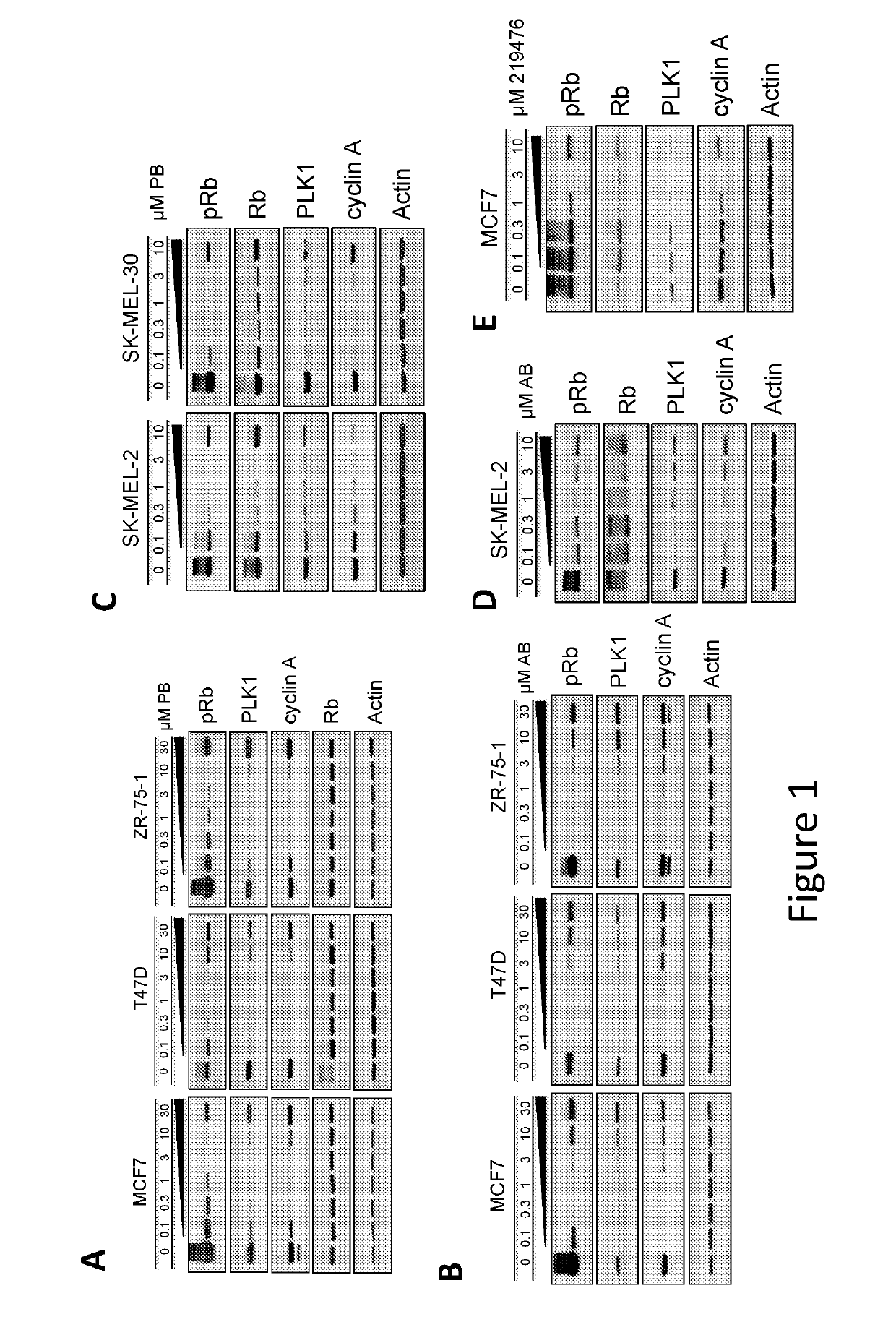Compositions and methods for treating cdk4/6-mediated cancer
a technology of cdk4/6 and chemotherapy, applied in the field of bivalent compounds, can solve the problems of limiting the administration of these inhibitors by toxicity
- Summary
- Abstract
- Description
- Claims
- Application Information
AI Technical Summary
Benefits of technology
Problems solved by technology
Method used
Image
Examples
example 1
[0204]Procedures for the Synthesis of VHL-1 Alkyl Linkers
[0205]To a solution of diacid (10 mmol) in DCM / THF (1:1, 200 ml) was added VHL-1 (2 mmol), triethylamine (1 ml, 7.1 mmol), HOAt (300 mg, 2.2 mmol), and EDCI (420 mg, 2.2 mmol) sequentially at 0° C. The resulting solution was stirred for 2 h at 0° C., before being warmed to room temperature (RT). After stirring overnight at RT, the reaction was quenched with water. After concentration under reduced pressure, the resulting residue was purified by reverse-phase chromatography to yield the desired product.
Linker 1: 4-(((S)-1-((2S,4R)-4-Hydroxy-2-((4-(4-methylthiazol-5-yl)benzyl)carbamoyl) pyrrolidin-1-yl)-3,3-dimethyl-1-oxobutan-2-yl)amino)-4-oxobutanoic acid
[0206](810 mg, 85%) as white solid. 1H NMR (600 MHz CD3OD) δ 9.10 (s, 1H), 7.51 (d, J=7.8 Hz, 2H), 7.44 (d, J=8.4 Hz, 2H), 4.64 (s, 1H), 4.60-4.49 (m, 3H), 4.39 (d, J=15.6 Hz, 1H), 3.91 (d, J=10.8 Hz, 1H), 3.82 (dd, J=9.6, 3.6 Hz, 1H), 2.67-2.55 (m, 4H), 2.52 (s, 3H), 2.25-2.2...
example 2
[0214]Procedures for the Synthesis of VHL-1 PEG Linkers
[0215]To a solution of diacid (4 mmol) in DMF (10 ml) and DCM (250 ml) was added NMM (10 mmol), VHL-1 (2 mmol), HOAt (2.4 mmol), and EDCI (2.4 mmol) at 0° C. The resulting reaction solution was stirred at 0° C. for 6 h and then at RT overnight. The progress of the reaction was monitored by LC / MS. After VHL-1 was totally consumed, the reaction was concentrated and the resulting residue was purified by reverse-phase chromatography to yield the product.
Linker 9: 2-(2-(((S)-1-((2S,4R)-4-Hydroxy-2-((4-(4-methylthiazol-5-yl)benzyl)carbamoyl) pyrrolidin-1-yl)-3,3-dimethyl-1-oxobutan-2-yl)amino)-2-oxoethoxy)acetic acid
[0216](810 mg, 69%) as white solid. 1H NMR (600 MHz, CD3OD) δ 8.97 (s, 1H), 7.47 (d, J=8.2 Hz, 2H), 7.43 (d, J=8.1 Hz, 2H), 4.69 (s, 1H), 4.60-4.47 (m, 3H), 4.36 (d, J=15.5 Hz, 1H), 4.27-4.17 (m, 2H), 4.16-4.07 (m, 2H), 3.89 (d, J=11.0 Hz, 1H), 3.81 (dd, J=11.0, 3.8 Hz, 1H), 2.48 (s, 3H), 2.22 (dd, J=13.1, 7.6 Hz, 1H), 2.0...
example 3
[0225]Procedures for the Synthesis of Pomalidomide Linkers
[0226]A solution of pomalidomide analogue (1 eq.), amine (1 eq.), and N,N-diisopropylethylamine (1.5 eq.) in DMF (2.0 ml per mmol of pomalidamide) was heated to 85° C. in a microwave reactor for 40 min. After cooling to RT, the reaction was quenched with water and extracted with ethyl acetate (3×). The combined organic phase was dried over anhydrous sodium sulfate and concentrated under reduced pressure. The resulting residue was purified by silica gel chromatography (eluted with hexanes / EtOAc: 0-100%) to give the desired t-Bu ester intermediate as oil. This intermediate was treated with a solution of hydrogen chloride in dioxane (4 M, 5 ml per mmol of pomalidamide) for overnight. After concentration under reduced pressure, the desired acid product was obtained as yellow oil.
Linker 18: 3-(2-((2-(2,6-Dioxopiperidin-3-yl)-1,3-dioxoisoindolin-4-yl)amino)ethoxy) propanoic acid
[0227]tert-Butyl 3-(2-aminoethoxy)propanoate (1.0 g, 5...
PUM
| Property | Measurement | Unit |
|---|---|---|
| molecular weight | aaaaa | aaaaa |
| flow rate | aaaaa | aaaaa |
| flow rate | aaaaa | aaaaa |
Abstract
Description
Claims
Application Information
 Login to View More
Login to View More - R&D
- Intellectual Property
- Life Sciences
- Materials
- Tech Scout
- Unparalleled Data Quality
- Higher Quality Content
- 60% Fewer Hallucinations
Browse by: Latest US Patents, China's latest patents, Technical Efficacy Thesaurus, Application Domain, Technology Topic, Popular Technical Reports.
© 2025 PatSnap. All rights reserved.Legal|Privacy policy|Modern Slavery Act Transparency Statement|Sitemap|About US| Contact US: help@patsnap.com



